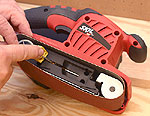This is a Veteran Owned site
![]()
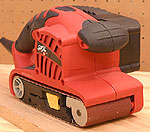 |
The Skil #7500 is sized and priced right for the woodworking shop. Click image to enlarge |
Skil #7500- 3" X 18" Belt Sander
The right size – the right features
Text & Photos by Tom Hintz
For a time the popularity of belt sanders amongst woodworkers dipped, in part due to the versatility of the newer random orbital sanders that out shined the often crude operating features of the belt sanders available at the time. That is changing, as evidenced by Skil's new #7500 belt sander.
Initial Impressions
 |
The large, top-mounted lock-on for the trigger is a nice and thoughtful touch. Click image to enlarge |
One of the first things I liked about the Skill #7500 was its overall size. Belt sanders always seemed bulky and awkward to me in the past, making them difficult to use without digging dips or grooves in woodworking projects. The Skill #7500 bucks that trend with its user-friendly size, weight and perhaps most importantly, its feel to the hand during use.
The Skill #7500 manufacturing looks to be well done, the controls and grips thoughtfully arranged and the operating features do not go beyond what a woodworker needs. Too many tools pile on features intended more as purchase-inducing eye candy and thankfully, Skil chose to forego that kind of marketing-driven add-on engineering.
The Features
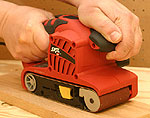 |
The grips are comfortable and placed to make using the #7500 easy on the hands. Click image to enlarge |
Designed around the popular 3" by 18" belt size, the Skill #7500 brings the features modern woodworkers need in a compact package. A 6-amp motor supplies more than sufficient power to drive the belt at an effective but controllable 1050 sfpm, (surface feet per minute) something that has been a problem with many earlier belt sanders. While the Skill #7500 removes material quickly, it is not so fast that digging ruts is a nearly automatic liability of using it. Use the right grit for the job and the Skill #7500 makes producing a smooth surface an easy task.
The primary and forward grips have rubber overmold panels that make them comfortable and resist slipping. Though everything on the Skill #7500 is "cheated" to the left to enable up-close, right side sanding, the grips give a balanced feel during use.
A nice touch is the large, top-mounted lock-on button that is far easier to engage than the traditional, and small, buttons manufacturers seemed to put in the most awkward position they could find.
Dust Control
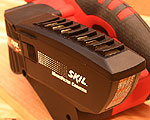 |
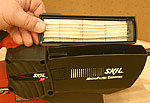 |
The MicroFilter dust canister (Left) is effective and the snap-off top (Right) with a pleated filter element needs only a few taps to clean before being returned to use. Click images to enlarge |
|
The efficiency of a belt sander means lots of dust to deal with. The Skill #7500 uses an internal, motor-driven fan and duct system that directs a surprising percentage of the dust to the on-board MicroFilter Canister. The canister has a pleated filter element above a baffled chamber that does a good job of letting clean air out while keeping the fine dust inside.
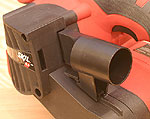 |
Skil includes this hose adapter that replaces the canister when a vacuum source is available. Click image to enlarge |
The MicroFilter canister is easily removed by depressing two latches and the top of the canister pops off separately for emptying. Tapping the filter element is all it takes to clean it for use. Both are good things because unlike some sander dust systems that are more visually reassuring than effective, this system actually does inhale dust and will need cleaning occasionally.
Skil goes a step further and includes a fitting for connecting a shop-vac hose that replaces the canister. The hose adapter has a 1 ½"OD which matches up to hoses commonly used on other hand-held power tools and the smaller adapters on many mid to small shop vacs.
Belt Changing/Tracking
The Skill #7500 uses a conventional flip lever to release and apply belt tension. However, while the tensioning is effective, the lever works easily unlike the same function on my other belt sanders that are so difficult to operate they could double as an arthritis test.
Skil also developed the AutoTrack Control belt tracking system that once adjusted, keeps the belt running true. I changed between three different belts and all tracked well after the initial (and very small) adjustment needed when using the Skill #7500 the first time.
Close-Up Sanding
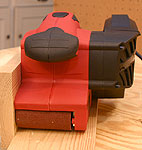 |
This right-side sanding capability comes in very handy more than you might think once it is available. Click image to enlarge |
The Skill #7500 is designed with the right side flat and aligned with the edge of the belt to allow sanding along an obstruction such as a cabinet side. This makes so much sense I wonder why it is not a standard feature on all belt sanders. Unfortunately, it isn't but Skil thought of it and woodworkers are going to appreciate it.
In the Shop
Putting the Skil #7500 to wood is a bit of a surprise. It feels lighter than the listed 8.2 lbs when running. Also, the 1050 sfpm belt speed is easy to control, in part because of the balance and handle design. Smoothing wood without carving grooves and gouges is much easier than with most of the larger, more aggressive belt sanders I have used. For woodworking, the Skil #7500 seems to have struck a good balance of power and control.
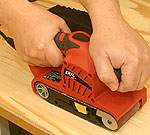 |
When put to wood, the Skil #7500 is surprisingly light feeling and easy to control. You know, like a woodworking tool is SUPPOSED to feel like! Click image to enlarge |
The relatively small size of the Skil #7500 makes using it in the spaces woodworkers find themselves in much easier. In addition, the flat right side allows sanding right up to a vertical obstruction and leaves only a small line along the corner to touch up. No more unintentional ramps in the corners of bookcases and cabinet shelves!
Using the Skil #7500 freehand, as when rounding table corners is also surprisingly easy with very good control. Here again, it feels lighter than claimed and that contributes to a solid feel of control, even at odd angles.
Throughout testing, the Skil #7500 performed very well and the belt needed no adjustments after the initial setup. I wore out the first belt sanding oak and never had to correct the tracking. That is a first for me with any belt sander.
Conclusions
The Skil #7500 is a great sander for the home woodworking shop but has all the power you might need for those occasional forays into home repair and remodeling. Equipped with the right grit belt for the job, the Skil #7500 does a very good job of smoothing stock without getting you in trouble with the addition of dips and grooves.
With a street price of only $68.00 (4-6-2006) the Skill #7500 is an affordable tool that will serve your workshop needs for many years with minimal impact on the budget. A belt sander may not be an everyday tool, but when you need one, the Skil #7500 is worth its weight in someone else’s elbow grease.
Visit the Skil Tools site - Click Here
Have a comment on this review? - Email Me!
All written, photographic and drawn materials are property of and copyright by NewWoodworker.com LLC 2000-2019. Materials may not be used in any way without the written permission of the owner.

